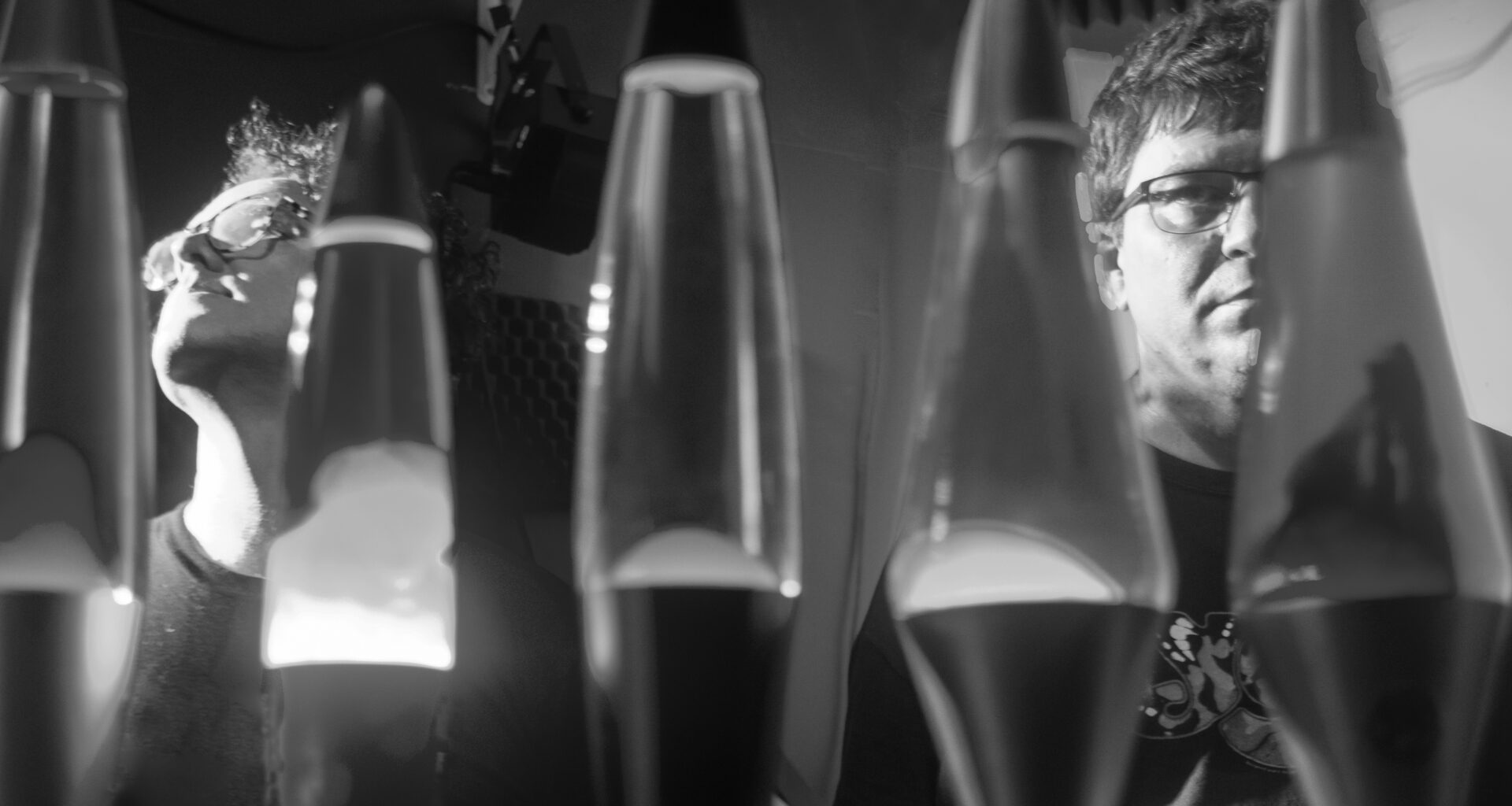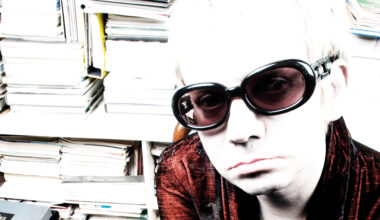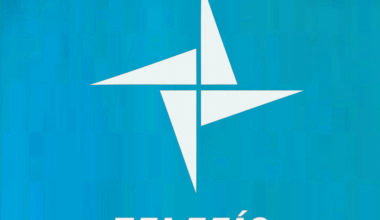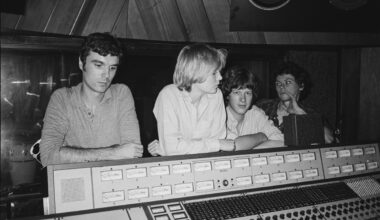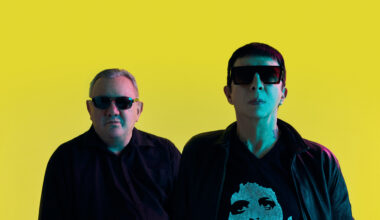A friendship forged in Tasmania, cemented in Sydney and immortalised in two two epic, yet intimate albums. Stewart Lawler and Jonathan Elliott are Kl(aüs) and they have something important to say about umlauts
There’s a man in Australia who had a Moog in his school music room. Is everybody jealous already?
“I arrived at high school in 1979 as a big fan of ‘Oxygène’,” says Stewart Lawler, one half of Sydney-based duo Kl(aüs). “I discovered the school had an electronic music studio, which was a basic Moog patchable modular and a four-track, and I took to it like a duck to water, because I’d been playing other musical instruments. My old man was an electronic technician, so I was already into the electronic and computing side of things.”
Over a crackly Skype connection that feels entirely in keeping with the nature of the vintage technology being discussed, Lawler is remembering his earliest experiences with electronic instrumentation. The other half of the partnership, Jonathan Elliott, nods appreciatively in an adjacent desktop window. They make a great double act. Lawler is fast-talking and irreverent, Elliott is laconic and self-deprecating, and they have the easy, laid-back repartee of long-term friends. It’s a relationship that dates back to their childhoods in late 1970s Tasmania, when Elliott befriended Lawler’s younger brother. Lawler was 11, Elliott was eight.
“My background is less interesting by a country mile,” adds Elliott, true to form. “I didn’t have much exposure to popular music up until I was 17 or 18. It took a chance encounter with ‘Oxygène’ while staying on some guy’s couch during a chess tournament, of all things, that told me this was a type of music that could more or less consume me.
“It wasn’t long before I encountered electronic instruments of a much less interesting kind than Stewart did… I reckon I saw a DX7 and a DX21, and my naïve little brain said, ‘Oh, these could conceivably make those noises’. Which of course, they couldn’t. But it was a jumping-off point, and the beginning of my interest in making this kind of music.”
The first, self-titled Kl(aüs) album was released on Castles In Space in 2016, and was a dreamy homage to the duo’s shared love of Tangerine Dream and the Berlin School of rhythmic ambience. Like all the best second albums, the recently released ‘2’ feels more ambitious in both scale and complexity, arguably drawing on the classical training that dominated the childhood experiences of both members.
“I was learning piano and singing everything from Victorian-era pop songs to medieval motets in the Rosny Children’s Choir,” remembers Lawler. “I wasn’t terribly good. I only got to Grade 6. He got to Grade 8 or something…”
“I got my Associates!” exclaims Elliott. “I’ve always said that people without talent but with determination can get their Associate Diploma of Music, and that’s me. And then people with talent can get the Licentiate Diploma of Music, which is essentially the concert pianist ticket, saying that you can play to concert standard. I was concentrating on that, more or less to the exclusion of actually doing any of my schoolwork, up until I was about 18. It didn’t really occur to me to listen to the radio, certainly not pop music on the radio, and looking back, I had an awful lot of catching up to do in my late teens and early 20s.”
Lawler made the move from Hobart to Sydney in 1990 (“seeking fame and fortune”) and saw Depeche Mode in their ‘Violater’ pomp on the first weekend in his adopted home. They were supported by Brisbane electropop outfit Boxcar. The latter were riding high on the back of Billboard Dance Chart success, and were not entirely averse to performing live in gas masks. In 1992, Lawler auditioned successfully to join them as a keyboard player, and support slots with the Pet Shop Boys, The Shamen and D:Ream swiftly followed.
“That D:Ream gig was hilarious,” he remembers. “We got up and started our set, and I was thinking, ‘Wow this is pretty cool, having hundreds of teenagers screaming at us’. Until I realised they were screaming for us to get off, because they wanted the main act.”
Playing with Boxcar brought Lawler to the attention of a hero of his teenage years – Tom Ellard, of Australian industrial giants Severed Heads. Their 1983 album ‘Since The Accident’ had been a formative favourite (“a mind-blowing, marvellous noise”) and his subsequent recruitment as Severed Heads’ keyboard player was the stuff of wild fantasy, beginning a musical association with Ellard that has lasted to the present day.
“The 16-year-old me would be shitting himself if he knew that he’d end up playing with Severed Heads and touring overseas,” he smiles.
Meanwhile, Elliott was spending his early 1990s attempting to forge a musical reputation back in Hobart.
“It’s a small place,” he says. “Certainly when I was at the age when I wanted to play in bands and get out there, the whole city was dominated by fairly noisy punk music, and I attached myself as keyboard player to a goth band, and played with those guys for five or six years. I started playing dance music in the early 1990s, very incompetently. And from the mid-1990s onwards, kind of competently.”
What was the goth band called?
“It had two incarnations. The first was called Prayers In Ashes.”
And the second?
“Blood Puppet. Which lacked a drummer. Basically, Prayers In Ashes’ drummer went deaf, these things happen, so Blood Puppet became a Sisters Of Mercy wannabe band, with me programming the drums and a lot of the other instruments. I’ve still got recordings.”
“Don’t let them leak onto the internet,” laughs Lawler.
Elliott followed Lawler to Sydney in 2003, and the duo, acquaintances at school, where that three-year age gap can seem almost insurmountable, quickly kindled a close adult friendship.
“We went out drinking a lot,” remembers Lawler, “going to goth clubs and talking about Tangerine Dream.”
And seemingly, it wasn’t long before the urge to make music together became irresistible. So was there a moment when Kl(aüs) were officially formed? Lawler pauses for thought.
“It was more a moment of ‘Oh, we’ve both got wives and rooms full of electronic equipment that they look askance at, and we haven’t got children, and we’ve got reasonable incomes, so let’s just go hire a space’.”
“I think Tom Ellard, once again, was on the periphery here,” adds Elliott. “He said, ‘I think you guys should do this’.”
A 2015 recording found its way to Scottish scenester Stuart “Frenchbloke” McLean, whose annual ‘The Dark Outside’ project transmits 24-hour radio broadcasts of previously-unheard music to remote British forest locations, for the exclusive pleasure of the huddled masses hidden between the trees. Word reached Colin Morrison, the one-man whirlwind at the helm of the Castles In Space label, who contacted the duo with thoughts of an album.
‘Kl(aüs)’ earned plaudits for bringing a “human” feel to its waveforms, and both Lawler and Elliott are keen to stress the improvisational origins of their music. Nascent tracks are jammed organically, before an extensive process of post-production. Lawler cites Dave Grohl’s 2013 documentary ‘Sound City’, detailing the golden age of the infamous LA studio, as an influencing factor, particularly a featured jam session between Paul McCartney and the surviving members of Nirvana.
“I’m not interested in that form of music at all,” Lawler explains, “but it just reminded me that when you get a group of musicians in a room together with their own specific voices and sounds, you can come up with something together that’s bigger than the sum of its parts. That’s what we’ve always said about Tangerine Dream too.”
“They are more than the musicians that are assembled in the room,” agrees Elliott. “It probably feeds into the idea that we tend to have short and medium-term collaborators.”
“We keep trying to get a third member, but they keep moving overseas!” laughs Lawler. “We’ve been through several, but that’s good because we get a diversity of different sounds on the records. I really like what [bassist] Simm Steel did on this new album. He’s a friend of mine, who I was in a band with when I first moved to Sydney in the early 1990s, and I only just recently caught up with him on Facebook. He came along and had a few sessions with us, and out of that came the ‘Alma Febles Struggles Into The Night’ track. And then he buggered off to live in the UK.”
At which point, both men express concern for guitarist Stuart McVicar, whose new home near Milton, New South Wales, puts him close to the recent Australian bushfires, news of which has loomed over our conversation throughout. Lawler describes his New Year’s Eve experience of “midnight at 11am”, and “ashy leaves coming out of the sky”. Although the recording of ‘2’ clearly predates the devastating developments, the elegant sweep of the music and the explanations of initially cryptic track titles, sometimes feel like an attempt to capture a gentler side of the natural world.
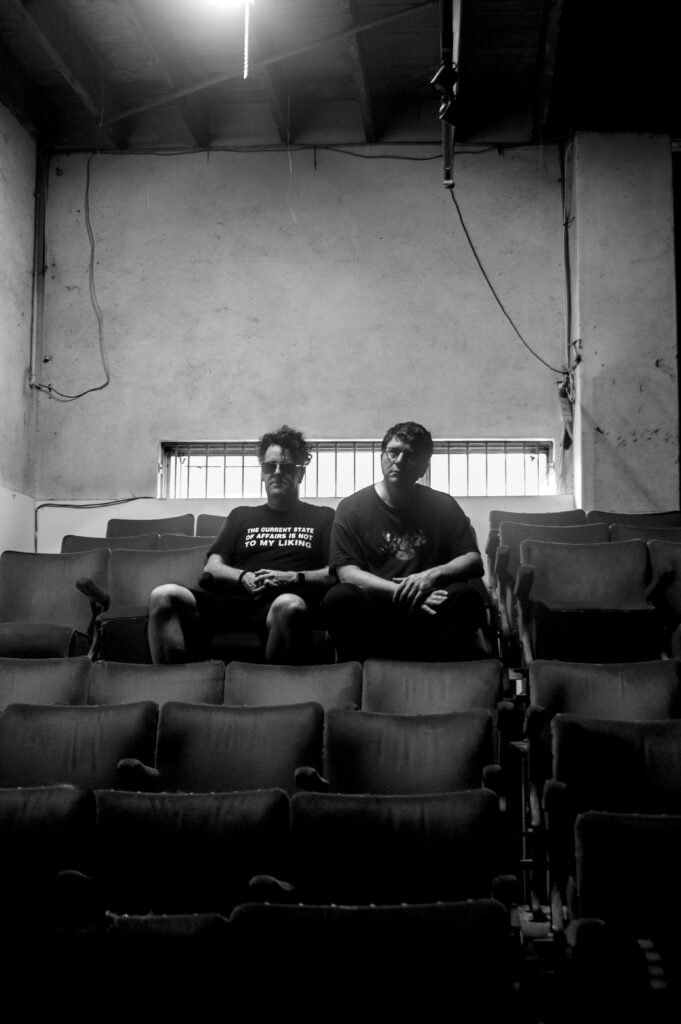
So the intrepid, cosmic-sounding ‘Shurnarkabtishashutu’ takes its title from a binary star in the constellation of Taurus, the original Arabic word translating evocatively as “Under the southern horn of the bull”. The pulsating ‘Mammatus Clouds Over Saskatchewan’, meanwhile, is named after Craig Lindsay’s extraordinary photograph of sunlit globular clouds, gathered in formation above silhouetted Canadian woodland. The duo, unsurprisingly, are pragmatic about these references.
“Officially, if there’s an astronomer in the group, it would possibly be me, because of my training,” says Elliott. “I’m a cosmic ray astronomer. But because the pieces are generally fairly filmic in one way or another, I think the titles on this album have been selected because they match the atmosphere of the piece of music, rather than anything else. So the atmosphere of ‘Mammatus Clouds Over Saskatchewan’ has, I wouldn’t say a grandeur exactly, but it’s got that sort of feel to it.”
“They’re really cute clouds,” shrugs Lawler. “And it rolls off the tongue in a funny way.”
Elsewhere, ‘Alma Febles Struggles Into The Night’ has its origins in a 1999 Lisa Belkin book, and neither Lawler nor Elliott profess to recall the origins of the hugely evocative ‘On The News It Looked Like She Was Floating’.
“Something I saw somewhere…” smiles Lawler enigmatically.
They are a hugely engaging partnership and the music reflects that. These are albums made by friends, by people with a warm and genuine connection, hunkered in a room and performing together with a clear sense of adventure and joy. They make the epic sound intimate.
“There’s something about the way we work,” agrees Lawler. “I think of it as a small ensemble. Just a set of instruments, each with their own lines interacting with each other. It’s a different way of thinking about composition. Starting off with a drum beat and a bassline, and ending up with a dance track is something that everyone else is doing, so we didn’t really want to do that.”
“We tend to play live from time to time and some of these gigs have been transcendent,” adds Elliott, characteristically pausing for thought. “Well, transcendent is a bit of a strong word. Hang on… some of these gigs have been very, very successful.”
And the conversation, not for the first time, descends into self-effacing laughter. And the name? It’s back to Tom Ellard and those Sydney pubs.
“Tom was telling us the story of Klaus Schulze’s manager having a rant about all the imitators out there and saying, ‘There is only one Klaus!’,” explains Lawler. “And it sounded like a good idea at the time. And then some wag on the internet suggested the brackets because ‘(Aus)’!
“And I just put the umlaut on it, even though I’m told it makes it all wrong. I thought if an incorrect umlaut is good enough for Motörhead, it’s good enough for us.”
“Apparently there is another electronic band in Argentina called Klaus,” adds Elliott. Someone who follows us suggested that they should have been called Kl(Arg)…”
‘2’ is out on Castles In Space
